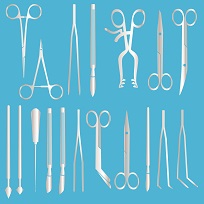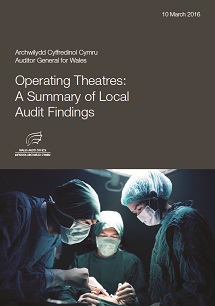Feature / Surgical precision
If, as is often said, A&E is the front door of acute hospitals, operating theatres could be seen as their foundations. Surgical patients are the source of much of the income they receive. And operating theatres account for almost 9% of acute care costs (not including medical staffing) – 19% of total costs where theatre costs are present – according to patient cost data published by NHS Improvement last month. A recent Wales Audit Office report (see box below) put the direct cost of operating theatre time at £14 per theatre per minute. With pressure on finances, this is clearly an area where trusts will hope to improve productivity and efficiency.
hospitals, operating theatres could be seen as their foundations. Surgical patients are the source of much of the income they receive. And operating theatres account for almost 9% of acute care costs (not including medical staffing) – 19% of total costs where theatre costs are present – according to patient cost data published by NHS Improvement last month. A recent Wales Audit Office report (see box below) put the direct cost of operating theatre time at £14 per theatre per minute. With pressure on finances, this is clearly an area where trusts will hope to improve productivity and efficiency.
Not surprisingly, theatre efficiency featured in the Carter report earlier this year – he said delayed transfers of care resulted in the sub-optimal use of clinical resources and treatment delays for other patients. The resultant loss of income cannot be offset, as costs are still incurred for clinicians, theatres and other overheads, the report added.
Unwarranted variations in theatres were also highlighted. Carter said deep wound infections for primary hip and knee replacements ranged from 0.5% to 4% of cases. If all hospitals achieved 1% infection rates, the NHS would transform the lives of 6,000 patients and save £300m a year.
Two years ago, NHS Providers carried out a benchmarking exercise on theatres, finding three key challenges that continue to resonate with operational and financial managers:
Effective planning On average, participants scheduled 35 hours of operating activity per theatre per week, of which 10% was cancelled, though the best performing trust managed to cancel only 3%.
Preventing last-minute changes Cancellation of procedures was not always under the control of the department – patient cancellations accounted for 39% of all last-minute procedure cancellations, while hospital cancellations due to clinical reasons accounted for 34% and the remainder were due to non-clinical reasons.
Efficient patient flow in the department Trusts wanted to reduce the theatre time wasted due to late starts and early finishes, which overall accounts for 18% of theatre hours used.
 NHS Providers head of analysis Siva Anandaciva (right) says trusts continue to focus on maximising the effective utilisation of theatres. ‘Providers are doing this by improving the effectiveness of how operating lists are scheduled, building more responsive and flexible work plans for consultants, and minimising delays to patient flow to and from theatres.
NHS Providers head of analysis Siva Anandaciva (right) says trusts continue to focus on maximising the effective utilisation of theatres. ‘Providers are doing this by improving the effectiveness of how operating lists are scheduled, building more responsive and flexible work plans for consultants, and minimising delays to patient flow to and from theatres.
He adds: ‘However, operating theatres are part of an interdependent system and their efficiency will always be reliant on general hospital patient flow. We are now seeing even the most effective providers struggling with increasing waiting lists, as the demand for emergency surgery and inpatient beds displaces planned elective operations.
‘For these reasons, providers are now looking at alternatives to transform the ways in which they work by consolidating surgical services, either across different sites within the same trust or across trusts to form specialty centres, as part of service transformation initiatives to improve theatre efficiency, safety and patient care.’
TPOT scheme
While individual trusts are targeting operating theatre efficiency, in England there is no national initiative. Around eight years ago, the then NHS Institute for Innovation and Improvement launched The Productive Operating Theatre (TPOT, pronounced ‘teapot’), which included efficiency and value as one of its themes – the others being team performance and wellbeing, safety and reliability, and patient experience and outcomes. It was adopted in hospitals across the UK.
An evaluation of the scheme, published in 2013, said the six organisations it studied, including four from the English NHS, had made significant savings. It suggested an average hospital with 16 theatres could save £7m a year, much of it on a recurrent basis.
A modular scheme, TPOT aimed to help staff identify and resolve everyday issues and frustrations using Lean principles. It included 13 modules, focusing on areas such as prompt starting times, patient turnaround to minimise gaps between operations, scheduling, organisation of theatres and ensuring that operational status can be understood at a glance.
Although the evaluation was positive, TPOT as a national scheme is no more, partly due to the institute’s closure in March 2013. But the materials for the scheme are still available through the institute’s legacy website, and finance and theatre managers say the best ideas – on making performance visible to all staff, for example – have become mainstream in most trusts.
Colchester Hospital University NHS Foundation Trust, for example, ended its scheme around three years ago. That does not mean individual elements or ideas have been abandoned. Wendy Hobbs, practice educator and theatre training lead at the trust – but previously in charge of TPOT there – says it has retained the scheme’s pre-session briefings.
‘Each theatre team meets before the list starts in the morning to discuss the individual patients from a surgical and anaesthetic perspective. They arrange the order of the list and discuss things such as whether specific instruments will be needed for particular patients. It’s an exercise in safety first, but also efficiency.’
At University Hospitals Bristol NHS Foundation Trust, TPOT and other earlier theatre efficiency initiatives had resulted in improved theatre efficiencies. But in 2014, finance director Paul Mapson recognised a new approach to theatre efficiency was needed. This led to a new trust-wide theatre transformation project to provide sustained improvements in efficiency.
The trust has 33 theatres on six different sites, covering adult and paediatric elective and emergency surgery. Jan Belcher is its theatre transformation project manager. From her diagnostic work, the project identified seven themes to be pursued:
- List structure and organisation
- Starting on time
- Turnaround time
- Patient flow in and out of recovery
- Integrated team working
- Data quality
- Performance management.
Recognising the importance of local ownership of improvement work, each theatre suite identified a lead practitioner representative and, following listening events and consultation, each suite identified its priorities within the seven themes. All departments were involved in the work to improve data quality and performance management and appointing departmental leads. Suites’ areas of focus were later confirmed, with good-quality data to support the need for action and to track improvement against agreed trajectories.
A broad range of projects have subsequently been implemented, including increased pre-operative assessment and a transfer nurse role to move patients from recovery to their ward, leading to better patient experience. There was also a focus on trauma list efficiency, using a team approach to the ‘golden’ first patient – the first patient on the surgical list is decided in advance and can be prepared and ready for the start of the session – and the implementation of an electronic display board to manage this cohort of patients.
Specialty rewards
A specialty approach also reaped rewards, particularly with ENT surgery, through improved scheduling and a focus on productivity. The team did not take a one-size-fits-all approach, Ms Belcher says.
Starting on time is a major challenge, and lack of available ward beds is one main cause of delays. The golden patient initiative is being rolled out to appropriate specialties to address this. Where possible, the norm will be that all golden patients are day cases unless otherwise indicated, though this is not feasible in many situations.
Team engagement and project ownership have been key to success and sustainability, and these remain critical factors in planning for theatre efficiency. Communications to keep staff informed are part of this, and information has been provided in a simple format to provide updates about progress and achievement.
‘Staff are, rightly, focused on quality, and safety and efficiency may be lower in their priority list. However, theatre efficiency dashboards showing performance over the previous week and months are shared with all theatre staff on notice boards, as well as through the intranet,’ says Ms Belcher.
Measures such as available theatre session uptake, start time, turnaround times within 15 minutes and recovery transfer delays are regularly reported and RAG rated for understanding at a glance. Progress and performance are regularly reviewed.
More recently, the key challenge across theatres has been around staff recruitment and retention, as without a stable workforce efficiency improvements are difficult to sustain. The programme organised a week-long staff engagement event, focusing on supporting teams to identify and address barriers to delivering quality care in a timely fashion.
Ms Belcher says: ‘It also provided a means to recognise and celebrate the amazing work that takes place in our theatres every day, and the efforts of staff to make this happen. The event proved very successful in engaging staff and refreshing energy for the next phase of improvement projects.’
Chris Kennedy, general manager for perioperative, critical care and pain at Guy’s and St Thomas’ NHS Foundation Trust, says it is using cost data to improve efficiency.
‘With help from the finance team, we worked out how much it cost per minute to run a theatre. Then, using the theatre management system, we worked out how much downtime there was across all theatres because of early finishes, delayed turnaround and cancellations. We were able to look at this by specialty and by theatre team and multiplied the downtime by cost per minute. We worked out we were wasting £15m a year. Because it was done using a financial model it allowed us to focus on the specialties where we were losing the most.’
The trust was able to develop a self-help tool and provide direct support for those specialties that needed more help. It quickly emerged that one of the key issues in high-turnover procedures was getting the patients through quickly enough. The reason was not enough staff to ensure an even flow of patients and optimise use of the theatres.
The trust’s solution is to create two teams for some lists. The trust cannot blindly throw additional resources at the issue, though; it has to be sure it is financially viable and the additional activity covers the cost.
‘Finding the staff is a challenge and there is an effort to reduce temporary staff costs, but as long as the additional activity covers the costs, I don’t think there is a problem with doing this,’ says Mr Kennedy.
Rolling out the initiative
The initiative is currently running in orthopaedics and gynaecology lists, as well as paediatric MRI. It is also to be trialled in urology.
‘If a session regularly has a turnover of four or five cases and an extra team would add a fifth or sixth case, we would ask if the extra investment of getting the additional staff justifies the cost,’ he says.
‘For some, we are looking at just doing this first thing in the morning – getting extra staff to do a relatively uncomplicated case first thing. It can take an hour or hour-and-a-half to anaesthetise some of our patients, so we can do this while the first patient of the day is in surgery.’
In this case, there would be two anaesthetists – one with the more complex patient, the other taking the less complex case from the anaesthetic room, through surgery and onto recovery. Similarly, for minor procedures such as in gynaecology there are two anaesthetists working in tandem to bring patients through and maximise theatre use.
If casemix suggests that a session could be made more productive by adding staff – either for the first procedure or for the whole session – it will be discussed with the appropriate surgical or theatre teams, costed and trialled for around a month. If it proves viable, additional staff will be made available for that session every week.
At Colchester, theatre manager Shelagh Lissone says the trust is taking steps to increase efficiency and safety in its theatres. Safety is a particular focus after the Care Quality Commission raised concerns recently. The theatre team monitors start and finish times, following up on reasons for delays and feeding back to clinicians.
It also hopes to try walking patients to surgery accompanied by a nurse this month, rather than on a bed pushed by a porter as it currently does – which relies on porters being available to get the patient in theatre on time.
Colchester is exploring reorganising its theatre schedule – arranging more all-day lists so it gets an extra hour of operating time (the all-day list is nine hours; the traditional schedule is two four-hour lists per day).
Despite efforts to minimise cancellations, they do occur. A theatre support manager chases the rescheduling of cancelled operations so the trust is not fined under the 28-day breach rule. This has improved the position, and there were no breaches in May.
At Guy’s, Mr Kennedy is the operational lead for the trust’s overarching work stream on surgical productivity, which looks at the whole patient pathway. He previously led the trust’s TPOT work, which was merged into the trust’s own theatre efficiency project.
In the past six years, he says, elective activity in the trust’s 44 theatres has increased from an average of 900 cases a week to 1,300. This is partly the result of extra hours – elective work is now scheduled for Saturdays – but there have been incremental gains from increased efficiency. Elective theatre use is about 90% and cancellations (due to the hospital and to patients not attending) have fallen from 9% to 7% in the past 18 months.
Theatre management is complex. Efficiency measures can have consequences for many parts of a hospital, including staffing and bed use, income and costs. Equally, decisions made in other parts of a hospital can have an impact on what theatres can achieve. Successful solutions will require the precision of a scalpel.
Welsh audit report
According to the recent Wales Audit Office  report Operating theatres: a summary of local audit findings, theatres are under-used and the national and local focus on theatre efficiency has waned in recent years
report Operating theatres: a summary of local audit findings, theatres are under-used and the national and local focus on theatre efficiency has waned in recent years
Though there was a lack of data, the
auditors said the prevalence of late starts is a good barometer for theatre productivity and they found this is common in Wales. While the reasons for cancellation of operations vary, almost half were because the patient cancelled or did not attend.
The WAO said there are a number of barriers to efficient theatres – including concerns over quality of theatre data and how it is used; difficulty finding beds; low staff levels; and fragmented accountability for the surgical pathway. Lack of good-quality data meant health boards struggled to dispel myths about the true causes of inefficiency.
The report made a number of recommendations:
- A renewed national and local focus on theatre efficiency
- Clarity of responsibility and clinical leadership along the pathway, with ‘robust executive oversight’
- The Welsh Risk Pool Service was unable to provide details of the cost of surgical litigation and the WAO said the service should work with the Welsh government to regularly analyse the costs and causes of litigation. They should aim to identify themes, spread learning and prevent issues arising in future
- Health boards should risk assess their current investment programme for renewing and replacing theatre equipment
- The government and health boards should agree a method of benchmarking staffing and skills levels in theatres to ensure safe and sustainable staffing
- Through a new national theatre forum, the government and health boards should agree a new dataset of efficient, productivity and safety measures to support comparison and learning. It is likely these would be a set of core measures, supplemented by some speciality specific measures
- Board meetings should regularly consider theatre efficiency and safety using data such as patient experience, use of theatre time, start and finish times, turnaround times and cancellations
- Up-to-date performance and safety information should be visible in operating theatres.
Related content
The Institute’s annual costing conference provides the NHS with the latest developments and guidance in NHS costing.
The value masterclass shares examples of organisations and systems that have pursued a value-driven approach and the results they have achieved.